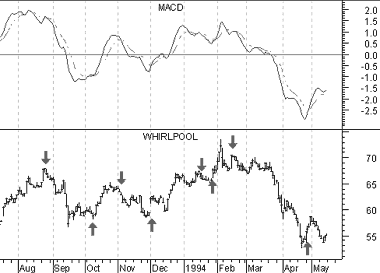|
M A C D
Overview
The MACD ("Moving Average Convergence/Divergence") is a trend following momentum indicator
that shows the relationship between two moving averages of prices. The MACD was developed
by Gerald Appel, publisher of
Systems and Forecasts.
The MACD is the difference between a 26-day and 12-day exponential moving average. A
9-day exponential moving average, called the "signal" (or "trigger") line is plotted on top
of the MACD to show buy/sell opportunities. (Appel specifies
exponential moving averages as percentages. Thus,
he refers to these three moving averages as 7.5%, 15%, and 20% respectively.)
Interpretation
The MACD proves most effective in wide-swinging trading markets. There are three popular
ways to use the MACD: crossovers, overbought/oversold conditions, and divergences.
Crossovers
The basic MACD trading rule is to sell when the MACD falls below its signal line.
Similarly, a buy signal occurs when the MACD rises above its signal line. It is also
popular to buy/sell when the MACD goes above/below zero.
Overbought/Oversold Conditions
The MACD is also useful as an overbought/oversold indicator. When the shorter moving
average pulls away dramatically from the longer moving average (i.e., the MACD rises), it
is likely that the security price is overextending and will
soon return to more realistic levels.
MACD overbought and oversold conditions exist vary from security to security.
Divergences
A indication that an end to the current trend may be near occurs when the
MACD diverges from the security. A bearish
divergence occurs when the MACD is making new lows while prices fail to reach new lows. A
bullish divergence occurs when the MACD is making new highs while prices fail to reach new
highs. Both of these divergences are most significant when they occur at relatively
overbought/oversold levels.
Example
The following chart shows Whirlpool and its MACD.
 I drew
"buy" arrows when the MACD rose
above its signal line and drew "sell" when the MACD fell below its signal line. I drew
"buy" arrows when the MACD rose
above its signal line and drew "sell" when the MACD fell below its signal line.
This chart shows that the MACD is truly a trend following indicator--sacrificing early
signals in exchange for keeping you on the right side of the market.
When a significant trend developed, such as in October 1993 and beginning in February 1994, the MACD was able
to capture the majority of the move. When the trend was short lived, such as in January
1993, the MACD proved unprofitable.
Calculation
The MACD is calculated by subtracting the value of a 26-day exponential moving average from
a 12-day exponential moving average. A 9-day dotted exponential moving average of the MACD
(the "signal" line) is then plotted on top of the MACD.
| MACD Stock Screener |
Action |
| MACD(12,26,9) Bullish Divergence |



|
| MACD(12,26,9) Crossed Above Signal Line |



|
| MACD(12,26,9) Crossed Above Zero |



|
| MACD(12,26,9) Above Signal Line |



|
| MACD(12,26,9) Above Zero |



|
| MACD(12,26,9) Bearish Divergence |



|
| MACD(12,26,9) Crossed Below Signal Line |



|
| MACD(12,26,9) Crossed Below Zero |



|
| MACD(12,26,9) Below Signal Line |



|
| MACD(12,26,9) Below Zero |



|
|
|

